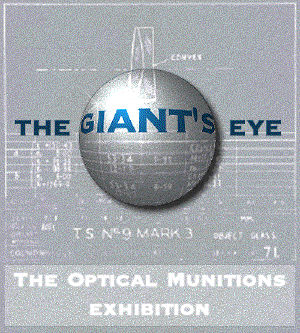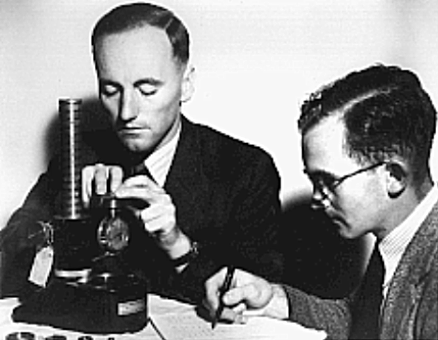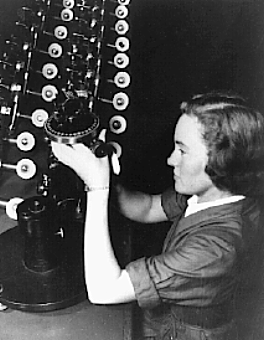This exhibition explores a little-known episode in Australia's scientific and war-time history - the Optical Munitions Panel, which came into being during the second world war in order to address the problem of munitions production.

The Giant's Eye: the Optical Munitions Panel Exhibition |
|
The final project we will examine is "The Giant's Eye: the Optical Munitions Exhibition" - a virtual exhibition on the WWW, created as a product of Bright SPARCS, by ASAP's Canberra staff, Denise Sutherland, Elissa Tenkate and Tim Sherratt. This exhibition explores a little-known episode in Australia's scientific and war-time history - the Optical Munitions Panel, which came into being during the second world war in order to address the problem of munitions production. |

|
| Isolation from our lines of supply in Britain with the advent of war meant that Australia had to produce its own weapons, in particular optical munitions - that is, optical instruments associated with weapons, such as: |
|
submarine and tank periscopes; telescopic rifle sights; camera lenses; and jungle sights. |
|
From 1940 to 1945 members of Australia's scientific community, from government laboratories, the Commonwealth Solar Observatory, industry and the universities, conducted research into and designed optical instruments. John Stewart Turner , whose records we mentioned earlier, was one of these scientists. The Optical Munitions Exhibition, which can be accessed now on the WWW, is not only an informative exhibition celebrating this story, but was, and is a great opportunity for ASAP to disseminate information about our online resource, Bright SPARCS. Bright SPARCS emerged from ASAP's database, the Register of the Archives of Science in Australia. The original database provided access to information on over 2000 Australian scientists form the eighteenth century to the present.
|

|

|
|
Brief biographical notes were provided together with a summary of any known archival source. Into this broad framework other resources have been woven, including a bibliographical register of Australian physicists - Physics in Australia to 1945 and the Biographical Memoirs of Fellows of the Australian Academy of Science. It is a great resource that continues to grow as we add more and create new links, interweaving information and resources. The impetus behind the Optical Munitions Exhibition springs from the vision of Bright SPARCS creator Tim Sherratt - that Bright SPARCS is more than just a database placed on the Web as a research resource. The Optical Munitions Exhibition stands alone as a resource in its own right, but its positioning as a virtual exhibition utilizing the great linking capabilities of the Web, begins to move it, and Bright SPARCS, into the realm of the active research environment. We have provided links to the Australian War Memorial WWW site, which also links to their Journal; to the Australian Embassy in America, which has an interesting site to explore if you want to find out more about Australia in general; to The Corning Museum of Glass, which can show you more about the history, chemistry and art of glass making and has a great scientific fudge recipe! And to the Mount Stromlo Observatory, which was very involved in the Optical Munitions project, and was where the exhibition was launched. Through these links and Bright SPARCS it is possible to get to the layers beneath the exhibition, to the archival resources. Since the launch of the exhibition in April we have been contacted by a number of people giving us additional information. We have new and corrected information on |
| Another way we have broadened our audience is through the Optical Munitions Avantcard - having the striking image of Ernst Hartung and Erich Heymann overseeing one of the early melts, reproduced on 5000 postcards that have been distributed Australia wide to galleries, museums, cafes and so on. |
| Tim Sherratt talking about the exhibition |

|

|
Gavan McCarthy and Sir Gustav Nossal |
| For archivists there is a world of opportunity on the Web and ASAP's experience of this has been well presented by former ASAP staffer Tim Sherratt in two excellent articles ("A world to win - The WWW experience of a small organisation with big dreams" and " Pathways to Memory - Accessing Archives on the WWW") available, where else, but on the Web. |
|
| |
|
Search |
Site Index |
ASAPWeb
Top of page | ASAP Articles Home
Published by the Australian Science Archives Project on ASAPWeb,
August 1997.
|